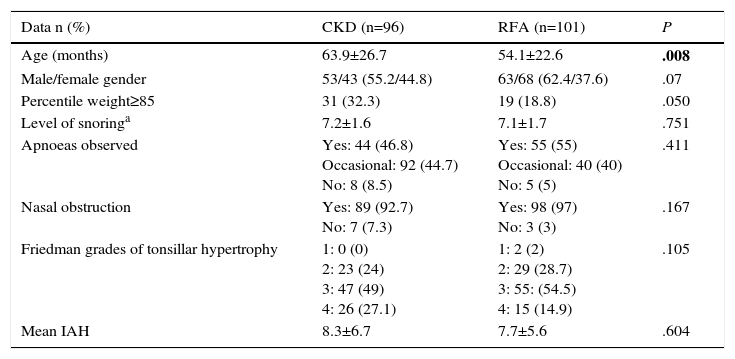Adenotonsillectomy for treatment of childhood obstructive sleep apnoea is effective. The uncomfortable postoperative period and possible complications have significantly increased the use of partial techniques, seeking to improve these aspects while achieving the same results in resolving sleep apnoea.
The aim was to present the experience with 2 consecutive groups of patients, comparing total tonsillectomy to bipolar radiofrequency ablation (RFA).
MethodA group of 96 children that underwent total tonsilloadenoidectomy using cold dissection were compared to another group of 101 children that underwent RFA. In all cases, polysomnography was performed before and 1 year after surgery. The percentage of cases with persistent disease (apnea-hypopnea index≥3) and the improvement of clinical symptoms at one year were evaluated. The percentages of surgical and anaesthetic complications in both groups were also compared.
ResultThe persistence of the syndrome was comparable in both groups: 25% in the cold dissection and 22.77% in the radiofrequency ablation group. Anaesthetic complications (5% in the group where cold dissection was used and 4.2% in the radiofrequency ablation group) and postoperative bleeding rates were very low and statistically comparable with both techniques.
ConclusionIn the treatment of childhood obstructive sleep apnoea syndrome, both extracapsular surgery using cold scalpel and bipolar radiofrequency tunnelling techniques are safe. Likewise, results as to resolution of the syndrome show no statistically significant differences.
La cirugía adenoamigdalar para el tratamiento de los niños con apnea obstructiva del sueño es efectiva. La incomodidad y posibles complicaciones del postoperatorio han promovido la utilización de técnicas parciales que buscan mejorar estos aspectos sin renunciar a resolver el síndrome con la misma efectividad.
El objetivo es presentar la experiencia de 2 grupos consecutivos de pacientes, uno tratado con cirugía amigdalar total extracapsular y otro con reducción con radiofrecuencia bipolar mediante tunelización.
MetodoSe comparan 96 niños tratados mediante adenoamigdalectomía total extracapsular con bisturí frío y 101 tratados mediante radiofrecuencia. Se evalúa el porcentaje de casos con persistencia del síndrome (índice de apnea-hipoapnea ≥ 3) y la mejoría de los síntomas clínicos a un año. Se compara también el porcentaje de complicaciones quirúrgicas y anestésicas en ambos grupos.
ResultadoLa persistencia del síndrome fue comparable estadísticamente en ambos grupos: 25% en el grupo de bisturí frío y 22,77% en el grupo de radiofrecuencia. Las complicaciones anestésicas (5% en el grupo de bisturí frío y 4,2% en el grupo de radiofrecuencia) y los porcentajes de hemorragia postoperatoria fueron muy bajos y estadísticamente comparables con ambas técnicas.
ConclusiónEn el tratamiento del síndrome de apnea obstructiva del sueño infantil, tanto la cirugía extracapsular con bisturí frío como la radiofrecuencia bipolar mediante tunelización son técnicas seguras y los resultados en la resolución del síndrome no muestran diferencias estadísticamente significativas.







